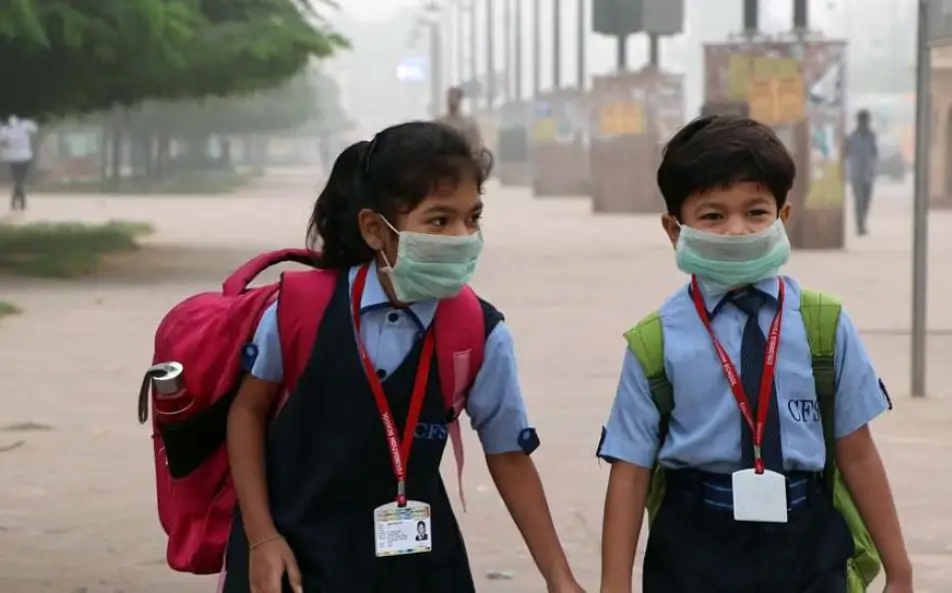CA
Tue, Dec 16, 2025 | 01:05 PM IST
| Delhi | 22°C

The United Indian



The thing about Delhi’s winters is that people expect the usual fog and cold breeze, but this time, the air feels different - heavier, almost like a blanket that refuses to lift. And the numbers reflect it, because every morning you look up Delhi AQI today, the scale is either red or maroon, and nobody is even surprised anymore. But what hits hardest is the effect on schooling, because children who should be worrying about homework and lunch breaks are now worrying about masks, irritated eyes and whether their network will hold long enough for the day’s lessons.
The government keeps switching to the Delhi air pollution schools hybrid mode, and while the intention is to protect children from stepping out in toxic air, what’s actually happening inside homes tells a very different story - one filled with improvisation, stress and a kind of helplessness that families rarely show on the outside.
Inside a one-room house in West Delhi, a girl sits on the floor with her younger brother, both of them waiting for their turn on their father’s phone because they have online classes for kids at the same time. Their father works as a driver and keeps his phone at home on days when school goes hybrid, which means he can’t take new bookings until the children finish. And the network keeps dropping. The screen freezes. The teacher’s voice becomes a robotic hum. The girl sighs, noting down whatever she can catch.
Stories like this repeat in neighbourhood after neighbourhood. Some children lean against windows hoping the signal improves, some ask neighbours for Wi-Fi passwords, and some simply give up and tell their teachers their “phone hung again.” The reality is, the digital divide isn’t a buzzword here - it’s an everyday experience repeating in thousands of homes where technology is a luxury, not a given.
And all this because the AQI outside makes it unsafe to breathe openly on the way to school.
Talking to teachers, you feel their exhaustion quietly sitting between their words. They stand in front of a half-filled classroom, trying to smile and maintain energy, while their laptop on the desk blinks with tiny faces waiting for attention. They repeat instructions twice - first for the children sitting right in front of them, then once more for the ones sitting miles away behind a shaky connection.
One teacher said she feels like she’s “splitting herself in half every single period,” because hybrid classes aren’t just about teaching in two modes, they’re about being patient with two entirely different realities. Children in the classroom raise hands easily, speak up, laugh, engage. Children online remain mostly muted, hesitant, unsure if their voice will carry clearly through unstable audio.
Teachers are trying, genuinely trying. But the emotional load is heavy. And it shows.
Parents have it no easier. They know the AQI outside is dangerous, and everything in them says, “Don’t send the child out.” But then the doubts creep in - if the child stays home for too long, will they fall behind? Will they understand the lesson if the internet cuts out again? Will they feel left out because others are attending offline?
One mother in Dwarka said she sends her son to school even when the AQI is in the “severe” zone because “I don’t have leave, and he won’t study at home without me.” Another parent refuses to send his daughter out at all, keeping her indoors even on slightly better days, and prays that the network doesn’t fail during the first period.
Parents are trying to make the best decision. But there is no ‘best’ here only the least painful choice available.
You can see it in their faces - the confusion, the tiredness, the disinterest that wasn’t there before. Children miss their friends, their school benches, even the noise of the classroom. But when they stay home because Delhi AQI today makes going out risky, the day feels stretched and disconnected.
Some children sit through classes in silence, unsure if speaking will make the audio glitch. Others watch the teacher explain something on the board but can’t see it clearly through a shaky camera. And some simply stare at the screen, confused, while their parents are away at work with no one to guide them.
Learning is not just reading chapters - it’s interaction, comfort, presence. Hybrid schooling breaks this rhythm for children, and the cracks are visible.
What pollution has done is expose something deeper. Children whose families can afford laptops and broadband still manage to stay afloat. But those with just one shared phone or weak mobile data fall behind step by step. The digital divide grows silently, widening each time hybrid learning becomes the default response to pollution.
The pain isn’t immediate. It shows later - weaker marks, loss of confidence, hesitation to participate. By then, the gap is already visible.
Delhi has lived with pollution for years, but the impact on schooling has never been so consistent. With the city entering the Delhi air pollution schools hybrid mode repeatedly, the pattern is becoming predictable - schools switch to hybrid, children shuffle between devices and classrooms, teachers juggle two modes, parents rearrange schedules, and once AQI improves, everything resets until the next spike.
But children do not reset as easily.
Some lose academic pace. Some develop anxiety about missing out. Some start associating schooling with discomfort or confusion. These are long-term consequences.
Delhi may get cleaner days eventually, but the educational strain left behind is not disappearing with the smog.
At The United Indian, stories like this aren’t just about pollution levels or school policies -they are about how a city’s children are learning to live within a crisis. The AQI may dominate the headlines, but inside homes, the bigger story is about connection, inequality and resilience. Hybrid schooling was meant to be a solution; today, it has become another reminder of how deeply air quality shapes the future of young minds.
Everything you need to know
Because Delhi AQI today has reached unsafe levels, and sending children outdoors was considered too risky.
Many students don’t have stable Wi-Fi or enough devices, which makes online classes for kids difficult and inconsistent.
Yes. They’re juggling two classrooms at once - one in front of them and one on screen making routine teaching far more exhausting.
Kids without proper devices or internet fall behind quickly. The digital divide makes learning unequal and frustrating for many families.
Most schools say yes. If the smog persists, the Delhi air pollution school's hybrid mode will continue to protect children from outdoor exposure.
#weareunited
We respect your privacy. Unsubscribe at any time. Privacy Policy
Nov 15, 2025
TUI Staff
Nov 10, 2025
TUI Staff
Aug 21, 2025
TUI Staff
Aug 05, 2025
TUI Staff
Comments (0)
Be the first to comment!